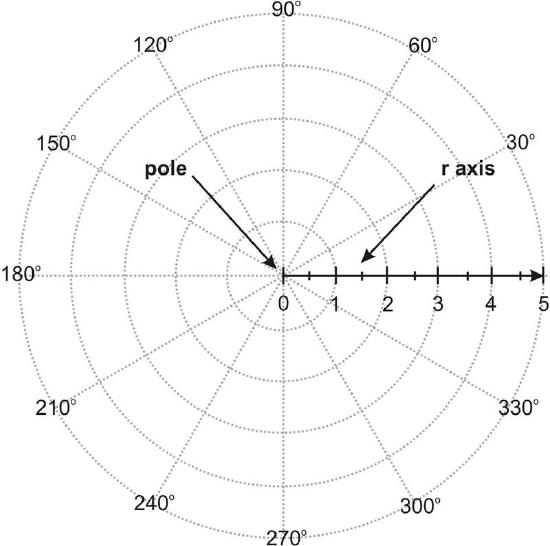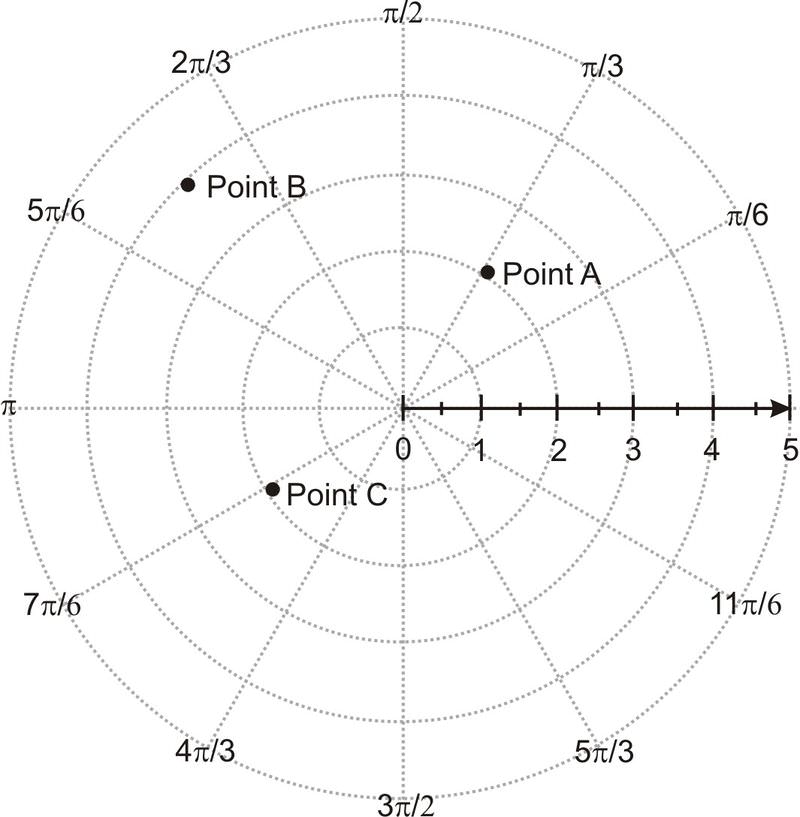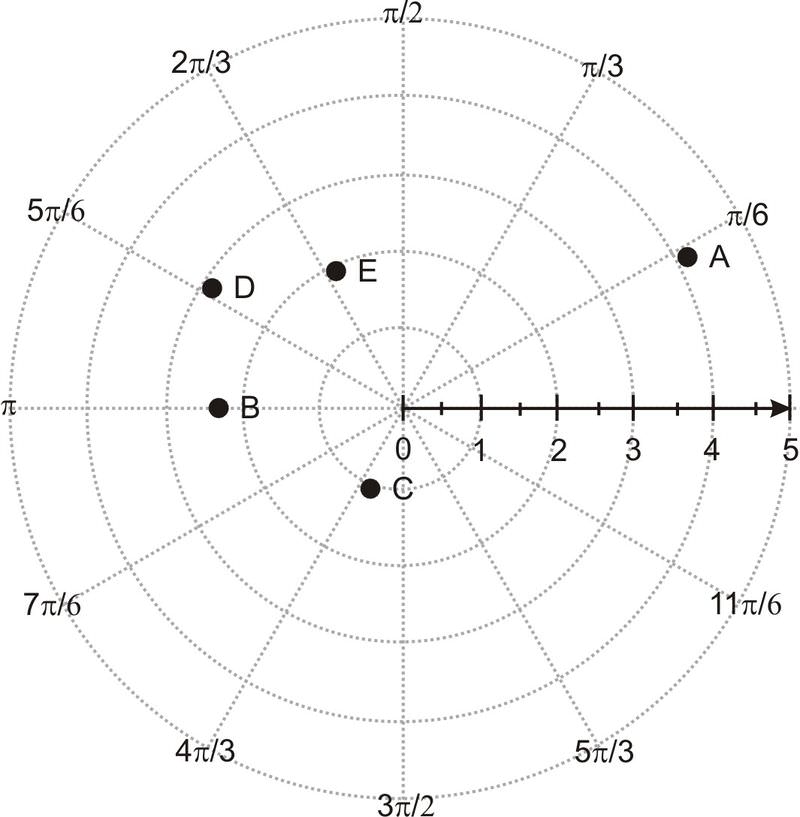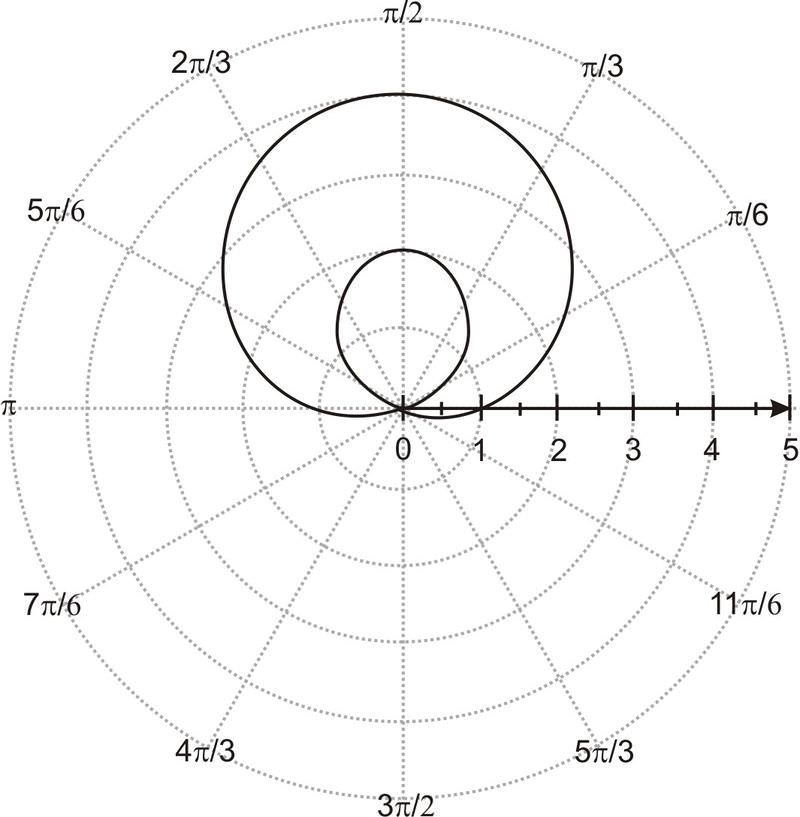4.4.1: Polar Coordinates
- Page ID
- 14428
Polar Coordinates
Everyone has dreamed of flying at one time or another. Not only would there be much less traffic to worry about, but directions would be so much simpler!
Walking or driving: "Go East 2 blocks, turn left, then North 6 blocks. Wait for the train. Turn right, East 3 more blocks, careful of the cow! Turn left, go North 4 more blocks and park."
Flying: "Fly 30 deg East of North for a little less than 11 and 1/4 blocks. Land."
Nice daydream, but what does it have to do with polar coordinates?
Polar Coordinates
The polar coordinate system is an alternative to the Cartesian coordinate system you have used in the past to graph functions. The polar coordinate system is specialized for visualizing and manipulating angles.
Angles are identified by travelling counter-clockwise around the circular graph from the 0 deg line, or r-axis (where the + x axis would be) to a specified angle.
 [Figure1]
[Figure1]To plot a specific point, first go along the r-axis by r units. Then, rotate counterclockwise by the given angle, commonly represented "θ". Be careful to use the correct units for the angle measure (either radians or degrees).
Radians
Usually polar plots are done with radians (especially if they include trigonometric functions), but sometimes degrees are used.
A radian is the angle formed between the r axis and a polar axis drawn to meet a section of the circumference that is the same length as the radius of a circle.
Given that the circumference of a circle is 2π⋅r, and since r is the radius, that means there are 2π radians in a complete circle, and 1π radians in 1/2 of a circle.
If 1/2 of a circle is π radians, and is 180 deg, that means that there are \(\ \frac{180}{\pi}\) degrees in each radian.
That translates to approximately 57.3 degrees = 1 radian.
Graphing Using Technology
Polar equations can be graphed using a graphing calculator: With the graphing calculator- go to MODE. There select RADIAN for the angle measure and POL (for Polar) on the FUNC (function)line. When Y = is pressed, note that the equation has changed from y = to r = . There input the polar equation. After pressing graph, if you can’t see the full graph, adjust x- and y- max/min, etc in WINDOW.
" frameborder="0" height="450px" name="92048" src="https://www.ck12.org/flx/show/video/...nates-Overview" thumbnailurl="" title="VideoObject?hash=1a6cbeee9e3598a31394e80c1e6462fd" uploaddate="2016-07-06 23:19:25" width="95%">
Examples
Plot the points on a polar coordinate graph: Point A \(\ \left(2, \frac{\pi}{3}\right)\), Point B (4, 135o), and Point C \(\ \left(-2, \frac{\pi}{6}\right)\)
Solution
Below is the pole, polar axis and the points A, B and C.
 [Figure2]
[Figure2]Plot the following points.
- (4, 30o)
- (2.5, \(\ \pi\))
- \(\ \left(-1, \frac{\pi}{3}\right)\)
- \(\ \left(3, \frac{5 \pi}{6}\right)\)
- (−2, 300o)
Solution
 [Figure3]
[Figure3]Use a graphing calculator or plotting program to plot the following equations.
- r=1+3sinθ
- r=1+2cosθ
Solution

- Review the steps above under graphing using technology if you are having trouble.
Convert from radians to degrees.
Recall that \(\ \pi r a d=180^{\circ} \text { and } 1 \mathrm{rad}=\frac{180}{\pi} \approx 57.3^{\circ}\)
- \(\ \frac{\pi}{2}\)
- 5.17
- \(\ \frac{3 \pi}{2}\)
Solution
- If \(\ \pi r a d=180^{\circ}\) then \(\ \frac{\pi}{2} r a d=90^{\circ}\)
- If \(\ 1 rad \approx 57.3^{\circ}\) then \(\ 5.17 rad \approx 296^{\circ}\)
- If \(\ \pi r a d=180^{\circ}\) then \(\ \frac{3 \pi}{2} r a d=270^{\circ}\)
Convert from degrees to radians.
Recall that \(\ \frac{180^{\circ}}{\pi}=57.3^{\circ} \approx 1 \mathrm{rad}\).
- 251o
- 360o
- 327o
Solution
- If \(\ 57.3^{\circ} \approx 1rad\) then \(\ 251^{\circ} \approx 4.38 \mathrm{rad} \approx 1.4 \pi \mathrm{rad}\)
- If \(\ 57.3^{\circ} \approx 1 rad\) then \(\ 360^{\circ} \approx 6.28 rad\)
- If \(\ 57.3^{\circ} \approx 1 rad\) then \(\ \frac{327^{\circ}}{57.3^{\circ}} \approx 5.71 rad\)
Convert from degrees to radians, answer in terms of π.
Recall that 2πrad=360o and therefore πrad=180o.
- 90o
- 270o
- 45o
Solution
- If \(\ \pi r a d=180^{\circ}\) then \(\ \frac{\pi}{2} r a d=90^{\circ}\)
- If \(\ \pi r a d=180^{\circ} \text { and } \frac{\pi}{2} r a d=90^{\circ}\) then \(\ 1 \frac{1}{2} \pi r a d \rightarrow \frac{3}{2} \pi \rightarrow \frac{3 \pi}{2} r a d=270^{\circ}\)
- If \(\ \frac{\pi}{2} r a d=90^{\circ}\) then \(\ \frac{\pi}{4} r a d=45^{\circ}\)
Review
- Why can a point on the plane not be labeled using a unique ordered pair (r, θ).
- Explain how to graph (r, θ) if r<0 and/or θ>360.
Graph each point on the polar plane.
- \(\ \text{A}\left(6,145^{\circ}\right)\)
- \(\ \text{B} (-2, \frac{13\pi}{6})\)
- \(\ \text{C} (\frac{7}{4}, -210^{\circ})\)
- \(\ \text{D}(5, \frac{\pi}{2})\)
- \(\ \text{E}(3.5, \frac{-\pi}{8})\)
Name two other pairs of polar coordinates for each point.
- \(\ (1.5, 170^{\circ})\)
- \(\ (-5, \frac{\pi}{-3})\)
- \(\ (3, 305^{\circ})\)
Graph each polar equation.
- \(\ r=3\)
- \(\ \theta=\frac{\pi}{5}\)
- \(\ r=15.5\)
- \(\ r=1.5\)
- \(\ \theta=-175^{\circ}\)
Find the distance between the given points.
- \(\ P_{1}\left(5, \frac{\pi}{2}\right) \text { and } P_{2}\left(7, \frac{3 \pi}{9}\right)\)
- \(\ P_{1}\left(1.3,-52^{o}\right) \text { and } P_{2}\left(-13.6,-162^{\circ}\right)\)
- \(\ P_{1}\left(3,250^{\circ}\right) \text { and } P_{2}\left(7,90^{\circ}\right)\)
Vocabulary
| Term | Definition |
|---|---|
| \(\ \pi\) | \(\ \pi\) (Pi) is the ratio of the circumference of a circle to its diameter. It is an irrational number that is approximately equal to 3.14. |
| Cartesian coordinate system | The Cartesian plane is a grid formed by a horizontal number line and a vertical number line that cross at the (0, 0) point, called the origin. |
| polar axis | The polar axis is a ray drawn from the pole at the 0∘ angle on a polar graph. |
| polar coordinate system | The polar coordinate system is a special coordinate system in which the location of each point is determined by its distance from the pole and its angle with respect to the polar axis. |
| pole | The pole is the center point on a polar graph. |
| radian | A radian is a unit of angle that is equal to the angle created at the center of a circle whose arc is equal in length to the radius. |
Image Attributions
- [Figure 1]
Credit: Unknown
Source: https://es.Wikipedia.org/wiki/Archivo:Lahore-PIA-747-TakeOff-80375.JPG - [Figure 2]
Credit: Unknown
Source: https://es.Wikipedia.org/wiki/Archivo:Lahore-PIA-747-TakeOff-80375.JPG - [Figure 3]
Credit: Unknown
Source: https://es.Wikipedia.org/wiki/Archivo:Lahore-PIA-747-TakeOff-80375.JPG

